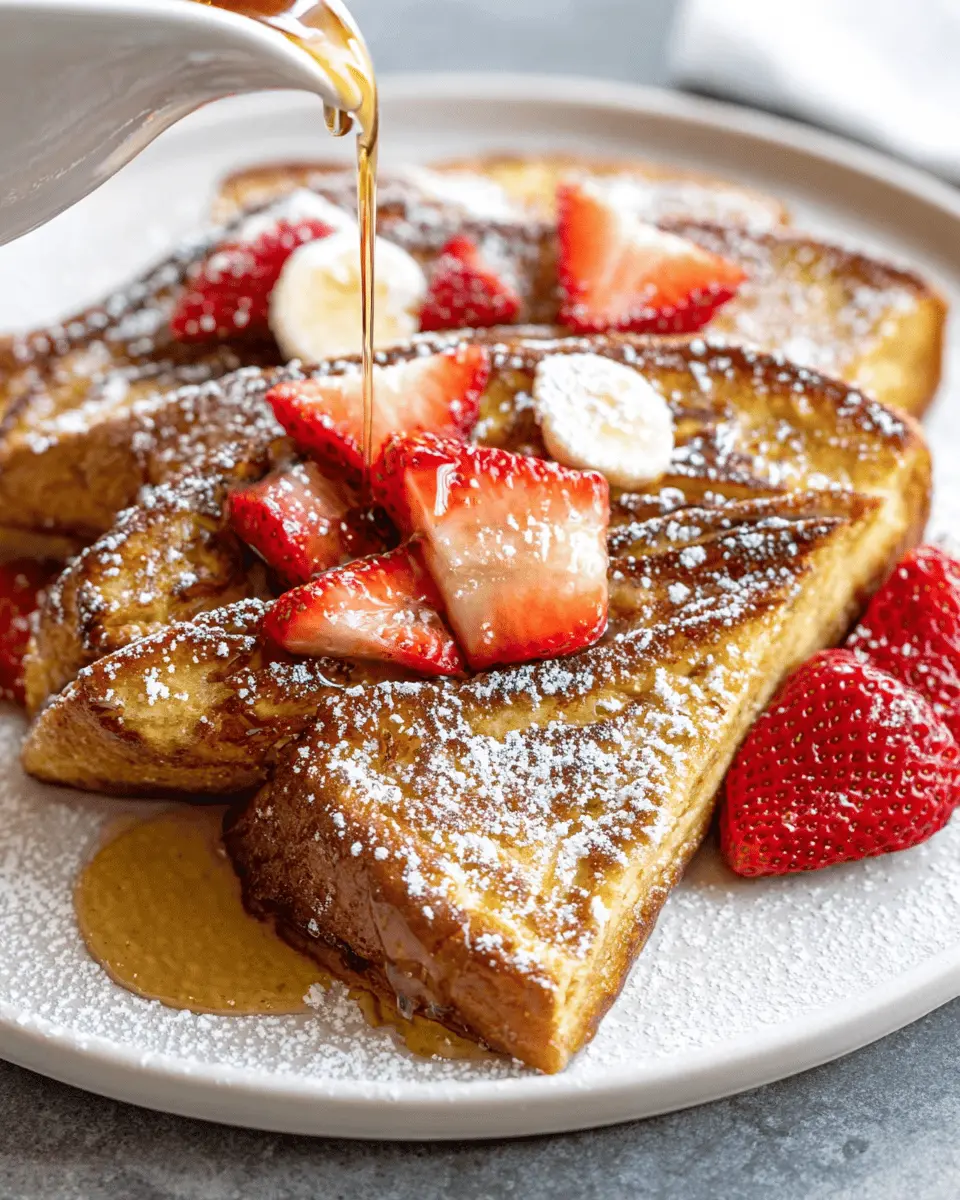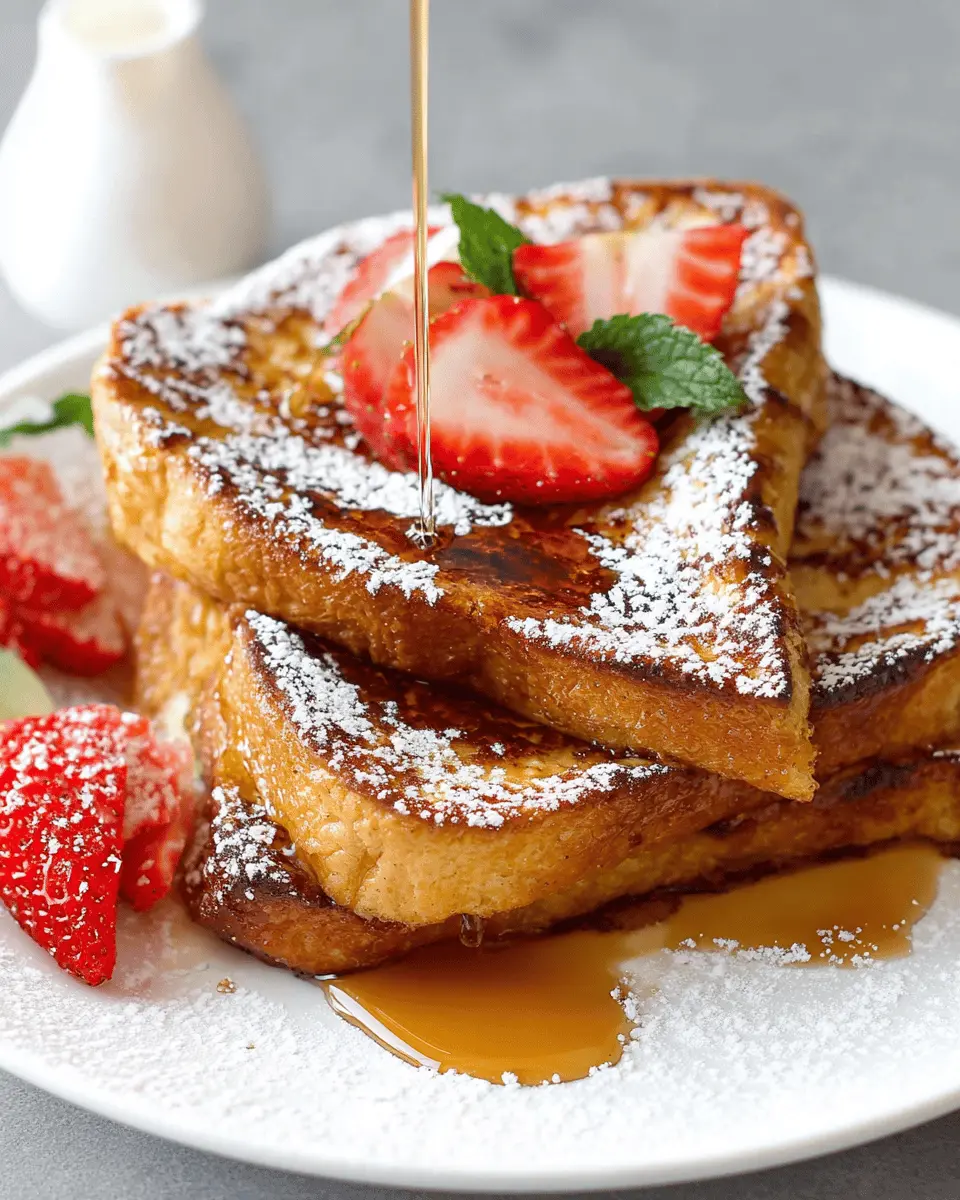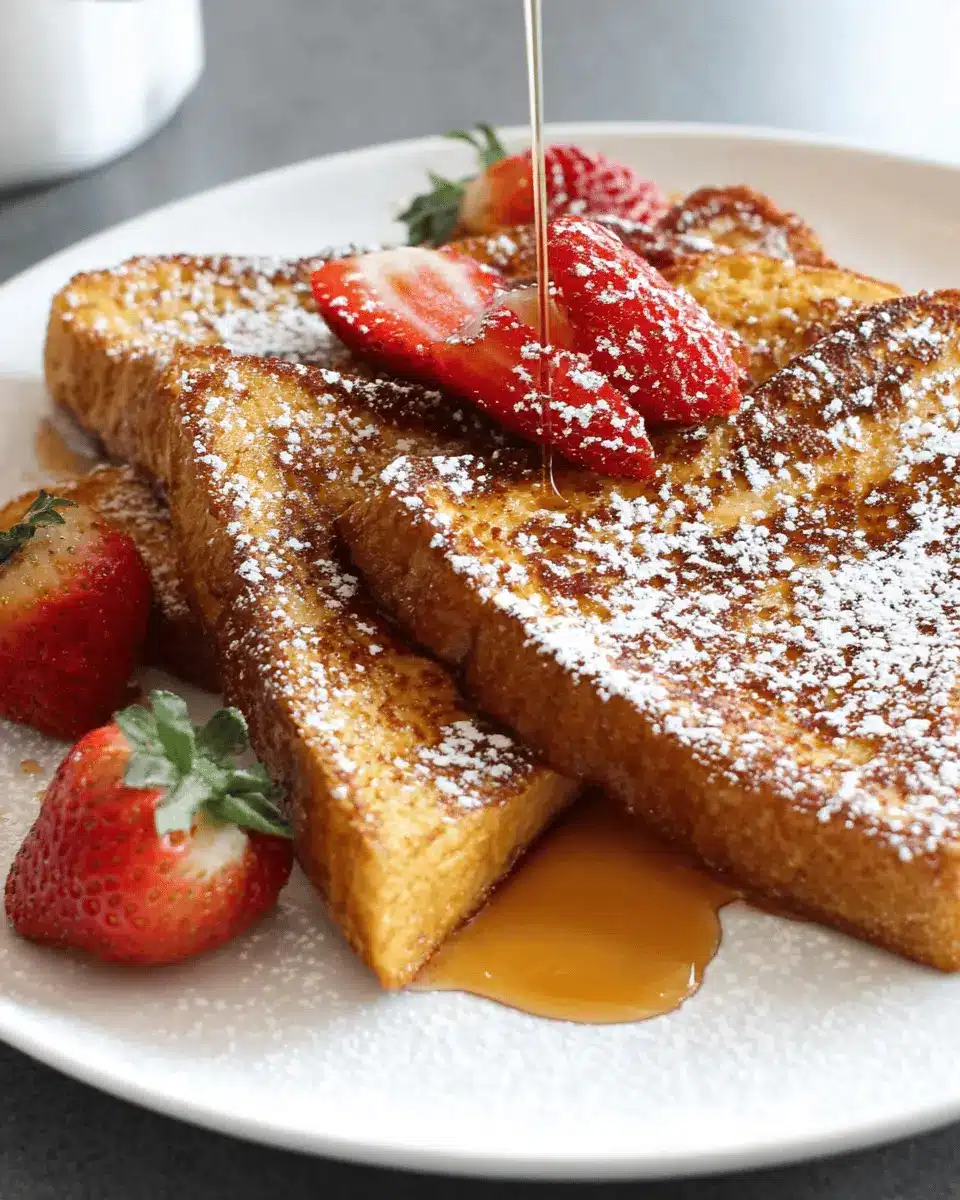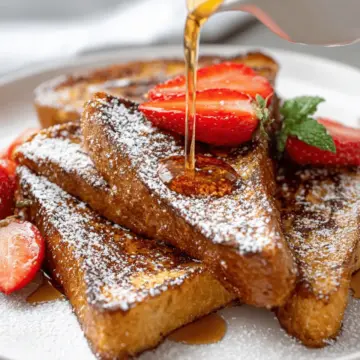Introduction to French Toast
If you’ve ever savored the delightful experience of French toast, you know it’s more than just a breakfast dish; it’s a comforting hug on a plate. This dish, often featuring crispy, golden-brown edges and a soft, custard-like center, provides the perfect balance of sweet and savory flavors that keep you coming back for seconds.
Why French Toast is the Perfect Breakfast Choice
So, why is French toast the ideal way to start your day? For one, it’s incredibly versatile. You can dress it up with fresh fruit, indulgent maple syrup, or even a sprinkle of powdered sugar—there are endless topping combinations to suit your taste. Additionally, French toast is user-friendly, making it accessible for beginners and seasoned cooks alike. With just a handful of ingredients—staples like bread, eggs, and milk—you can whip up a delicious meal in no time.
A survey by the National Restaurant Association shows that breakfast foods, particularly variations like French toast, are more popular than ever, proving that this dish continues to delight diners of all ages. Plus, it’s a fantastic way to use up stale bread that might otherwise go to waste—talk about a win-win! Whether you’re enjoying it solo on a Sunday morning or serving it at a holiday brunch, French toast is sure to add a dash of joy to your breakfast table.

Ingredients for French Toast
Essential Ingredients for Classic French Toast
Creating delicious French toast relies on a few key ingredients that combine to form the perfect balance of flavors and textures. Here’s what you’ll need to whip up this breakfast classic:
-
Bread: Start with 8 slices of white bread, preferably ⅔ to ¾ inches thick for that ideal custardy center and crispy exterior.
-
Eggs: Grab 2 large eggs along with 2 egg yolks; this combo adds richness that makes each bite irresistible.
-
Milk: Use 1 cup (240 ml) of milk for the custard. Whole milk works great, but feel free to experiment with alternatives like almond or oat milk for a twist.
-
Sweetener: A tablespoon of brown sugar or granulated sugar helps bring out the flavors beautifully.
-
Flavorings: Add 1 teaspoon of pure vanilla extract, ¾ teaspoon of cinnamon, ⅛ teaspoon of nutmeg, and ¼ teaspoon of kosher salt for that warm, comforting taste.
-
Butter: You'll need 2 tablespoons of unsalted butter to ensure that everything cooks to perfection.
This simple but effective lineup is what turns ordinary bread into the ultimate breakfast delight. For more tips on ingredient selection, check out resources like Epicurious or Serious Eats. Happy cooking!
Preparing French Toast
French toast is a beloved breakfast dish that brings a touch of buttery sweetness to any morning. The secret to achieving that perfect balance of crispy and custardy lies in the preparation. Let’s break down the steps to prepare this delightful dish.
Dried Bread Preparation
To start your French toast adventure, you'll want to ensure your bread is slightly dried out. Fresh bread can be too soft and won’t soak up the custard mixture properly. Preheat your oven to 300ºF (149ºC). Place your slices on a wire rack set over a baking sheet and dry them out for about 10 to 14 minutes. This step enhances the texture and ensures your French toast has that desired crunch. Alternatively, a toaster on the lowest setting works well for small batches. Bring out that crispy potential!
Make the Custard Mixture
While your bread is drying, it’s time to craft the custard mixture. In a large, shallow bowl, whisk together the following ingredients:
- 1 cup (240 ml) milk
- 2 large eggs
- 2 egg yolks
- 1 tablespoon (10 g) brown sugar (or granulated sugar)
- 1 teaspoon (5 ml) pure vanilla extract
- ¾ teaspoon cinnamon
- ⅛ teaspoon nutmeg
- ¼ teaspoon (1 g) kosher salt
This custard is where the magic happens! The combination of eggs and milk creates a rich, creamy base that perfectly coats the bread. Dr. Oz recommends letting the custard rest for a few minutes—this helps the flavors meld together for an even richer taste.
Soak the Bread Slices
Once your custard is ready, carefully soak each dried slice of bread for about 15 to 20 seconds on each side. You want them to absorb just the right amount of liquid without getting overly soggy. Place the soaked slices on a separate baking sheet as you go, and don’t forget to whisk the custard as needed to keep everything mixed evenly. Want an extra flavor kick? Sprinkle a bit more cinnamon on top for good measure.
Fry the Bread to Perfection
Now comes the exciting part—frying! Heat a nonstick pan or cast iron skillet over medium-low heat and melt ½ tablespoon of butter until it bubbles. Place two pieces of soaked bread in the pan at a time. Cook until the underside is golden and crisp, about 3 to 5 minutes. Flip and cook the other side until it has that gorgeous golden hue. If you're preparing a large batch, keep the finished pieces warm in a preheated 200ºF (93ºC) oven.
Serving the French Toast
Finally, the best part—serving! Just before presenting your French toast, dust with powdered sugar for an enticing finish. Serve it drizzled with warm maple syrup and your choice of toppings, like fresh berries or a dollop of whipped cream. Each bite will be a delightful blend of textures and flavors that might just become your new weekend ritual!
Now you're ready to impress friends, family, or even just yourself with your beautifully prepared French toast. Enjoy this classic dish, and feel free to share your results!

Variations on French Toast
French Toast with Different Breads
While traditional French toast typically uses white bread, there are so many delicious alternatives to explore! Try brioche for an extra rich texture, whole grain bread for a healthy twist, or even challah for a slightly sweet flavor. Sourdough adds a tangy zing, making each bite a delightful surprise. Have you ever considered using bagels? They create a unique and satisfying crunch that pairs perfectly with cream cheese or fruit spreads. Get creative—the type of bread you choose can elevate your French toast game!
Savory French Toast Options
If you’re in the mood for something savory, consider making French toast with cheese and herbs. A sprinkle of aged cheddar and fresh chives transforms this breakfast classic into a gourmet delight. Alternatively, try incorporating Turkey Bacon or Chicken Ham for added protein. You could also whip up a savory French toast casserole with layers of spinach and feta, perfect for sharing at brunch! Need more inspiration? Check out this savory French toast recipe to spark your culinary imagination!
These variations not only provide new flavors but also keep breakfast exciting!
Cooking Tips and Notes for French Toast
Achieving the Perfect Custard Mixture
For a dreamy French toast experience, ensure your custard is well-mixed. Whisk the eggs and milk thoroughly, incorporating the sugars and spices for a flavorful blend. Use full-fat milk for creaminess, and don't skip the vanilla—it adds a lovely aroma! If you have a blender, it can make the mixing even easier.
Keeping the French Toast Warm for Serving
If you plan to serve a crowd, keep your French toast warm in a 200ºF (93ºC) oven. Just place the finished slices on a baking sheet, and pop them in until ready to serve. This technique helps maintain their fluffy center and crispy exterior—perfect for those sluggish weekend mornings!
Feel free to pair your French toast with fresh berries or a sprinkle of nuts for added texture. Happy cooking!

Serving Suggestions for French Toast
Creative Toppings to Elevate Your French Toast
Transform your French toast into a flavor masterpiece with a variety of toppings! Consider fresh berries, sliced bananas, or even grilled peaches for a fruity kick. Drizzle with caramel sauce, or opt for a dollop of whipped cream for that indulgent touch. Don’t overlook the classic pairing of pure maple syrup, which adds a warm sweetness that complements the dish perfectly. For a gourmet twist, sprinkle some chopped nuts for crunch or a pinch of sea salt to enhance the sweetness.
Pairing Drinks with Your French Toast
What to sip alongside your delicious French toast? A robust cup of coffee is always a winner, especially when you’re looking to start your day right. For something refreshing, try an iced chai latte or a vibrant smoothie made with your favorite fruits. If you prefer something non-caffeinated, herbal teas or a zesty citrus juice can perfectly complement the sweetness of the toast. Enjoy experimenting with these options for a breakfast that's both delicious and rejuvenating!
For more inspiration, check out some delicious drink recipes here.
Time Breakdown for French Toast
When you're craving a comforting dish like French Toast, it's essential to plan your time effectively. Here’s a quick breakdown:
Preparation Time
Allow 30 minutes to gather ingredients, prepare your bread, and mix the custard. This step sets the stage for a delicious breakfast!
Cooking Time
Set aside 50 minutes to fry your slices to golden perfection. This includes cooking in batches, ensuring each slice captures that delightful, crispy texture.
Total Time
In total, you’ll need 1 hour and 20 minutes from start to finish. Perfect for a leisurely weekend brunch with friends or family!
For more tips on perfecting your French Toast, consider checking out culinary experts like Serious Eats. Happy cooking!
Nutritional Facts for French Toast
Calories and Macronutrients
Per serving of French toast (one slice), you’ll find approximately 138 calories. This delightful breakfast packs 16g of carbohydrates, 6g of protein, and 6g of fat, making it a balanced option to start your day.
Vitamins and Minerals
This French toast also provides essential nutrients, including Vitamin A (226 IU) and Calcium (114 mg), promoting healthy vision and bone strength. Plus, it features Iron (1 mg) to help support your body's energy levels. Indulging in this tasty dish not only satisfies your hunger but also contributes to your nutritional needs!
For more detailed nutritional insights, consider visiting nutrition.gov or USDA's FoodData Central, where you can explore a variety of food facts and guidelines.
FAQs about French Toast
What type of bread is best for French Toast?
When it comes to crafting the perfect French toast, the type of bread you choose can make all the difference. Ideally, you want a bread that is thick, sturdy, and has a bit of texture. Options like brioche, challah, or sourdough work wonderfully. Their density allows them to soak up the custard mixture without falling apart, resulting in a delightful balance of crispy and creamy.
How can I make French Toast ahead of time?
Making French toast ahead of time is a savvy way to enjoy a stress-free breakfast. You can prepare the custard and soak the bread the night before, placing them in a covered dish in the refrigerator. In the morning, just cook them up! Alternatively, you can fry the slices and keep them warm in a low oven until you’re ready to serve.
For more detailed tips on meal prep, check out resources from Food Network and Serious Eats.
Can I make French Toast without eggs?
Absolutely! If you're looking for an egg-free version of French toast, simply use a mixture of almond milk or soy milk combined with a tablespoon of cornstarch or ground flaxseed to act as a binder. This will give you a deliciously custardy texture without the eggs, making it suitable for those with dietary restrictions.
Conclusion on French Toast
French toast is a delightful breakfast option that brings warmth to your mornings. With its simple preparation and endless customization, it's perfect for any day of the week. Enjoy it topped with maple syrup, fresh fruits, or even Turkish coffee. Savor each bite and make it your own!

French Toast Delight with Turkey Bacon and Chicken Ham Twists
Equipment
- 12-inch nonstick pan
- wire rack
- baking sheet
- toaster
Ingredients
- 8 slices white bread ⅔ to ¾" thick
- 1 cup milk (240 ml)
- 2 large eggs
- 2 egg yolks
- 1 tablespoon brown sugar or granulated sugar
- 1 teaspoon pure vanilla extract (5 ml)
- ¾ teaspoon cinnamon
- ⅛ teaspoon nutmeg
- ¼ teaspoon kosher salt (1 g)
- 2 tablespoons unsalted butter (30 g)
- ¼ cup powdered sugar (24 g)
- 1 cup pure maple syrup (240 ml)
Instructions
- Dry the Bread - If using soft, fresh bread, set the oven rack to the middle position and preheat to 300ºF (149ºC). Place the slices on a wire rack set on a baking sheet. Warm the bread until dry to the touch but not browned, about 10 to 14 minutes, flipping halfway through.
- Make the Custard - In a large shallow bowl, whisk together the milk, eggs, egg yolks, brown sugar, vanilla, cinnamon, nutmeg, and salt.
- Dip the Bread - Soak the bread for 15 to 20 seconds on each side. Use a spatula to transfer to a separate baking sheet. Whisk the custard as needed in between batches to keep the ingredients mixed. Sprinkle more cinnamon on top if desired.
- Fry the Bread - Heat a 12-inch nonstick pan or cast iron skillet over medium-low heat. Melt ½ tablespoon of butter until it bubbles. Add two pieces of bread at a time. Cook until the first side is golden brown and lightly crisp, about 3 to 5 minutes. Flip and cook the other side until golden, about 3 to 4 minutes.
- To Serve - Right before serving, sprinkle powdered sugar on top. Serve with maple syrup or desired toppings.

Leave a Reply